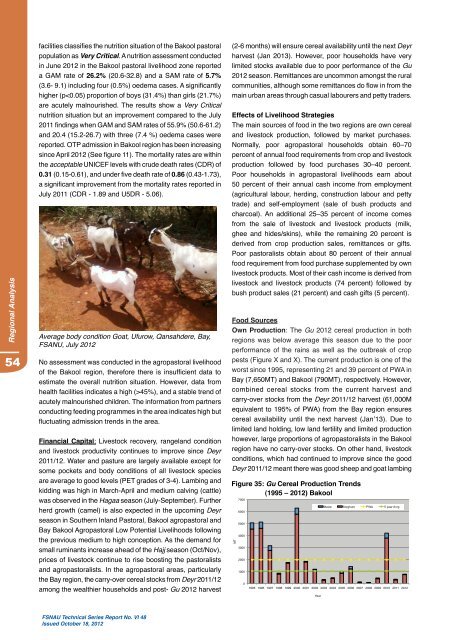Fsnau-Post-Gu-2012-Technical-Report
Fsnau-Post-Gu-2012-Technical-Report
Fsnau-Post-Gu-2012-Technical-Report
You also want an ePaper? Increase the reach of your titles
YUMPU automatically turns print PDFs into web optimized ePapers that Google loves.
Regional Analysis<br />
54<br />
facilities classifies the nutrition situation of the Bakool pastoral<br />
population as Very Critical. A nutrition assessment conducted<br />
in June <strong>2012</strong> in the Bakool pastoral livelihood zone reported<br />
a GAM rate of 26.2% (20.6-32.8) and a SAM rate of 5.7%<br />
(3.6- 9.1) including four (0.5%) oedema cases. A significantly<br />
higher (p45%), and a stable trend of<br />
acutely malnourished children. The information from partners<br />
conducting feeding programmes in the area indicates high but<br />
fluctuating admission trends in the area.<br />
Financial Capital: Livestock recovery, rangeland condition<br />
and livestock productivity continues to improve since Deyr<br />
2011/12. Water and pasture are largely available except for<br />
some pockets and body conditions of all livestock species<br />
are average to good levels (PET grades of 3-4). Lambing and<br />
kidding was high in March-April and medium calving (cattle)<br />
was observed in the Hagaa season (July-September). Further<br />
herd growth (camel) is also expected in the upcoming Deyr<br />
season in Southern Inland Pastoral, Bakool agropastoral and<br />
Bay Bakool Agropastoral Low Potential Livelihoods following<br />
the previous medium to high conception. As the demand for<br />
small ruminants increase ahead of the Hajj season (Oct/Nov),<br />
prices of livestock continue to rise boosting the pastoralists<br />
and agropastoralists. In the agropastoral areas, particularly<br />
the Bay region, the carry-over cereal stocks from Deyr 2011/12<br />
among the wealthier households and post- <strong>Gu</strong> <strong>2012</strong> harvest<br />
FSNAU <strong>Technical</strong> Series <strong>Report</strong> No. VI 48<br />
Issued October 18, <strong>2012</strong><br />
(2-6 months) will ensure cereal availability until the next Deyr<br />
harvest (Jan 2013). However, poor households have very<br />
limited stocks available due to poor performance of the <strong>Gu</strong><br />
<strong>2012</strong> season. Remittances are uncommon amongst the rural<br />
communities, although some remittances do flow in from the<br />
main urban areas through casual labourers and petty traders.<br />
Effects of Livelihood Strategies<br />
The main sources of food in the two regions are own cereal<br />
and livestock production, followed by market purchases.<br />
Normally, poor agropastoral households obtain 60–70<br />
percent of annual food requirements from crop and livestock<br />
production followed by food purchases 30–40 percent.<br />
Poor households in agropastoral livelihoods earn about<br />
50 percent of their annual cash income from employment<br />
(agricultural labour, herding, construction labour and petty<br />
trade) and self-employment (sale of bush products and<br />
charcoal). An additional 25–35 percent of income comes<br />
from the sale of livestock and livestock products (milk,<br />
ghee and hides/skins), while the remaining 20 percent is<br />
derived from crop production sales, remittances or gifts.<br />
Poor pastoralists obtain about 80 percent of their annual<br />
food requirement from food pur chase supplemented by own<br />
livestock products. Most of their cash income is derived from<br />
livestock and livestock products (74 percent) followed by<br />
bush product sales (21 percent) and cash gifts (5 percent).<br />
Food Sources<br />
Own Production: The <strong>Gu</strong> <strong>2012</strong> cereal production in both<br />
regions was below average this season due to the poor<br />
performance of the rains as well as the outbreak of crop<br />
pests (Figure X and X). The current production is one of the<br />
worst since 1995, representing 21 and 39 percent of PWA in<br />
Bay (7,650MT) and Bakool (790MT), respectively. However,<br />
combined cereal stocks from the current harvest and<br />
carry-over stocks from the Deyr 2011/12 harvest (61,000M<br />
equivalent to 195% of PWA) from the Bay region ensures<br />
cereal availability until the next harvest (Jan’13). Due to<br />
limited land holding, low land fertility and limited production<br />
however, large proportions of agropastoralists in the Bakool<br />
region have no carry-over stocks. On other hand, livestock<br />
conditions, which had continued to improve since the good<br />
Deyr 2011/12 meant there was good sheep and goat lambing<br />
Figure 35: <strong>Gu</strong> Cereal Production Trends<br />
(1995 – <strong>2012</strong>) Bakool<br />
MT<br />
7000<br />
6000<br />
5000<br />
4000<br />
3000<br />
2000<br />
1000<br />
0<br />
1995 1996 1997 1998 1999 2000 2001 2002 2003 2004 2005 2006 2007 2008 2009 2010 2011 <strong>2012</strong><br />
Year<br />
Maize Sorghum PWA 5 year Avrg


